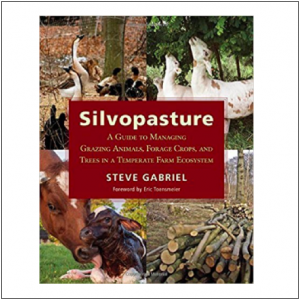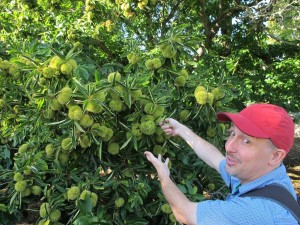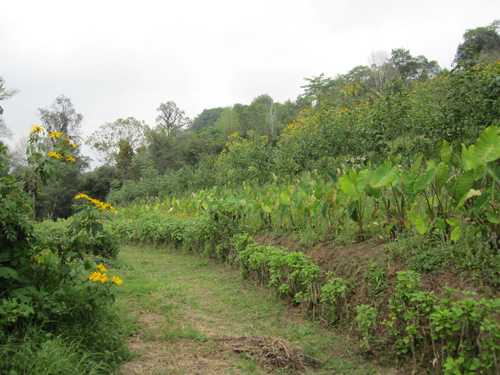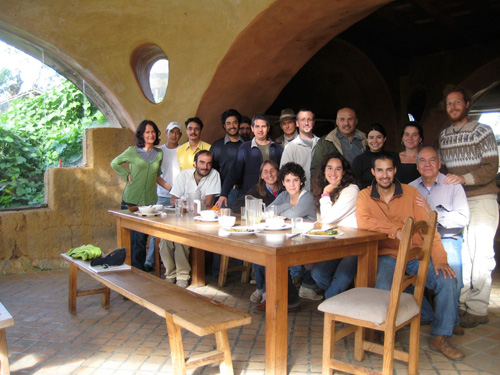On my way home from a great “intermediate forest garden” weekend workshop at Green Light Plants in Landenberg PA. Dale Henricks of Green Light was our host, his house is lovely and the garden is pretty fantastic.
Green Light Plants is Dale Hendricks’ nursery specializing in native permaculture plants and other cool stuff. They have wholesale quantities, while I was there they had 2700 pawpaw seedlings potted up! Dale uses organic materials and reusable pots.
He has many plantings, 15 years old, primarily natives from before his permaculture awakening. Now planting out forest garden polycultures with an emphasis on useful natives, especially pawpaws and groundnuts. Dale received a collection of 30 groundnut accessions including improved varieties and has selected four elite clones that set large tubers in a single season which he will offer through the nursery.
We toured several polycultures at GLP, including an “instant thicket” that was pretty great. This is an extension to an existing vegetable and fruit garden, well-fenced from deer. It contains part of Dale’s collection of 30 selected groundnut varieties, from which he has selected four elite strains that form large tubers in a single year from planting. Here’s Dale:
Amazingly all this growth from a food forest planted just this spring! Credit Dale’s fertile soils and use of biologically charged biochar and compost, plus his experienced green thumb.
Tiny jujube and American persimmon trees will someday form an open canopy. Currently the shrub layer is occupied by a big row of raspberries, and a thicket of named varieties of elderberry and sunchoke. Groundnuts climb the trellis fences at the edges and a row of Russian comfrey makes a nice border. This polyculture is almost all native.
Another interesting polyculture is an understory for recently planted pawpaws designed and installed by Aaron Guman in 2011. Young pawpaws planted with rings of wild indigo, lemon balm, “Hidecote Blue” comfrey, Turkish rocket, green and gold. Areas between these plantings planted out with raspberries.
Every species thriving, all dense one year after planting, very little room for weeds, very few weeds. Very impressive! I don’t think any of my polycultures have ever filled in this nicely this soon after planting. Dale also grows garlic in this bed during this early succession phase with great success. Here’s Aaron:

This polyculture includes fruit (pawpaw, raspberry), nectar and habitat plants (comfrey, lemon balm, green and gold), a nitrogen fixer (wild indigo), and a perennial vegetable (Turkish rocket). Pretty much all the herbaceous species combine to make a great groundcover.
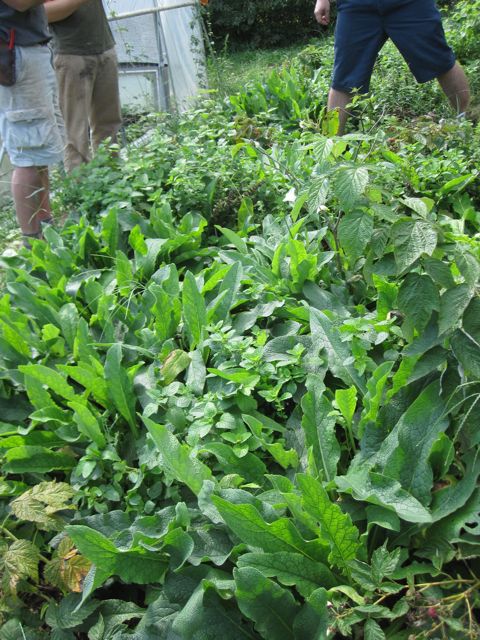
Dale has a nice stand of 10′ pawpaws, planted on contour. Interestingly, grafted trees were “standards” with good light underneath, while seedling trees were multistemmed with much denser shade below. This contour planting is just uphill from the 1 year-old polyculture Aaron planted.
During the workshop we designed and planted out an understory for these pawpaws. Fortunately for us, Dale has a great nursery and tons of plants. Here’s what we put in:
Full shade under seedling trees: ramps, toothwort, hog peanut (based on another polyculture here on apios), Virginia waterleaf, wild ginger.
Part shade under grafted pawpaws: giant Solomon’s seal, “Hidecote Blue” comfrey.
Sunny edges: (which some day will be shaded out as pawpaws downhill grow up): green and gold, Chinese artichoke.
Almost all native. Edibles: ramps, toothwort, hog peanut, Solomon’s seal, waterleaf, ginger, artichoke. Nectary or habitat: green and gold, comfrey. Nitrogen: hog peanut. Groundcovers: essentially all species.

You can read more in my posts at the Apios Institute forest garden wiki.

